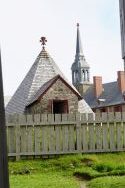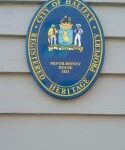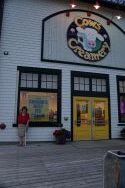I’m sitting in the Quality Inn Halifax reflecting on our week-long trip to the Atlantic Provinces, grateful that our 24 hour plane delay (due to maintenance!) came at the end of our trip; had it come at the beginning, we might have had to scramble to book new reservations. By and large, we stayed at bed-and-breakfasts that had limited capacity, and this is the busy time of year up here (like so much of the north woods, which it resembles, you have 3 months or so to survive on tourism, now the number 1 industry in Nova Scotia).
Indeed, the decline of the traditional fishing (cod overfished, I understand), and oil, coal, and steel industries were factors that led to the recreation of Fortress Louisbourg, reconstructed as part of a “make work” project in the 1960s, and lasting nearly 20 years.

 Louisbourg was the largest French fort in the New World—for good reason. As the British and French sparred to control, ultimately, the Great Lakes and their access to the Mississippi and Ohio valleys, the deep harbor (85 feet at the entrance), easily controlled entrance (there was only one channel into the harbor), and its ice-free qualities suited it well. The French constructed it after 1713, when one of the many European wars resulted in France ceding Nova Scotia to the British, but retaining Cape Breton Island, which is where Louisbourg sits.
Louisbourg was the largest French fort in the New World—for good reason. As the British and French sparred to control, ultimately, the Great Lakes and their access to the Mississippi and Ohio valleys, the deep harbor (85 feet at the entrance), easily controlled entrance (there was only one channel into the harbor), and its ice-free qualities suited it well. The French constructed it after 1713, when one of the many European wars resulted in France ceding Nova Scotia to the British, but retaining Cape Breton Island, which is where Louisbourg sits.

 The location and harbor made it a big trading port—ultimately fourth largest in North America—after Charleston, New York, and Boston. It was profitable for Louis XV, too; the cod generated over 3X the revenue of the fur trade. As our guide explained, 19 million Catholics in France had 145 meatless days (Friday, Lent, etc.), which generated a lot of shipping. (Incidentally, France still controls St. Pierre and Miquelon in the St. Lawrence, the cod fishing rights being the one thing retained in the treaties after various wars).
The location and harbor made it a big trading port—ultimately fourth largest in North America—after Charleston, New York, and Boston. It was profitable for Louis XV, too; the cod generated over 3X the revenue of the fur trade. As our guide explained, 19 million Catholics in France had 145 meatless days (Friday, Lent, etc.), which generated a lot of shipping. (Incidentally, France still controls St. Pierre and Miquelon in the St. Lawrence, the cod fishing rights being the one thing retained in the treaties after various wars).
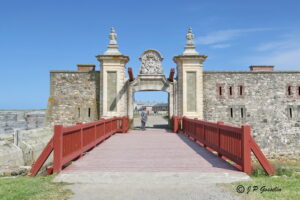 The ill-defined boundaries, tensions, and European wars, however, led a British-Massachusetts force to besiege Louisbourg in 1745, and capture and occupy it. The treaty ending THAT war returned the fortress to the French. The Fortress (a designation given to an enclosed city) resumed its importance to the French, eventually reaching several thousand fishermen and merchants in the city. The governor of the province—with really elegant quarters in the King’s Bastion, had, in 1744, over 5,000 bottles of wine in his cellar.
The ill-defined boundaries, tensions, and European wars, however, led a British-Massachusetts force to besiege Louisbourg in 1745, and capture and occupy it. The treaty ending THAT war returned the fortress to the French. The Fortress (a designation given to an enclosed city) resumed its importance to the French, eventually reaching several thousand fishermen and merchants in the city. The governor of the province—with really elegant quarters in the King’s Bastion, had, in 1744, over 5,000 bottles of wine in his cellar.
 The fortress currently features 1744 persona, before the first siege. One of the female slaves, freed, became the first black woman businessman in
The fortress currently features 1744 persona, before the first siege. One of the female slaves, freed, became the first black woman businessman in  Canada. If you come next year, our guide assured us, there will be a reenactment of the six-week siege. I doubt that the governor’s wine cellar will be available, though.
Canada. If you come next year, our guide assured us, there will be a reenactment of the six-week siege. I doubt that the governor’s wine cellar will be available, though.
As part of the French and Indian War, on his way to besiege and capture Quebec, General Wolfe besieged and captured Louisbourg. As was typical, the British had over four times the army, and four times the navy. This time, fearful that the diplomats would give it back, Wolfe ordered it destroyed.
And so it remained until the Canadian government rebuilt about 40% of it, mostly the residences and shops, to give an idea of what it must have been like to live in the Fortress, or as in the case of many fishermen, just outside the fort. There’s two rebuilt gates—the important one in the harbor—but for me the King’s bastion was the neatest building, with the chapel, the 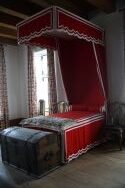 governor’s sumptuous quarters, and single officer’s housing. Married officers built or rented their own houses, and several were rebuilt. One attractive feature of the New World was that it was healthier–50% of infants in France died before the age of 1; one in six children in New France died before the age of 12. The garrison, mostly Marines, signed up for 6 years, but many borrowed from officers to make ends meet (9 livres was pay, 7 livres deducted for room and board), and wound up extending enlistment to repay debts.
governor’s sumptuous quarters, and single officer’s housing. Married officers built or rented their own houses, and several were rebuilt. One attractive feature of the New World was that it was healthier–50% of infants in France died before the age of 1; one in six children in New France died before the age of 12. The garrison, mostly Marines, signed up for 6 years, but many borrowed from officers to make ends meet (9 livres was pay, 7 livres deducted for room and board), and wound up extending enlistment to repay debts.
There were various programs, many of them charging a fee: firing a cannon and learning about artillery, for example. You could also spend a night in one of the rebuilt hotels, or in a tent, like the ones we have in Troop 19 for our reenactments at Fort de Chartres.
Interestingly enough, the last buildings were in the 1980s; since Canada enacted a law forbidding the building on the original site (to protect artifacts) the Fortress will give you only a good idea of what it looked like—but you’ll have to imagine what 2 ½ miles of walls would look like.
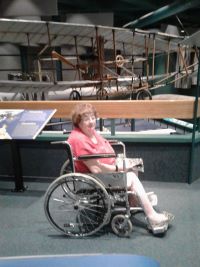 It certainly makes Fort de Chartres look like what it was—a frontier outpost on the fringe of empire.
It certainly makes Fort de Chartres look like what it was—a frontier outpost on the fringe of empire.
One unanticipated gem on the way back to our plane: the Alexander Graham Bell National Historical Site in Baddeck, Nova Scotia, the summer residence of the Bell family. Known for developing the telephone, Bell was a polymath. Among his other inventions: a hydrofoil. The journey……

